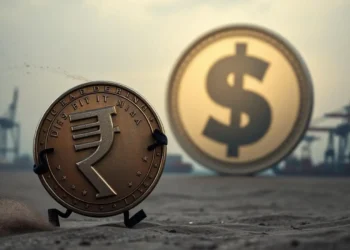According to a report in Indian Express, Department of Economic Affairs Secretary Ajay Seth said the capex push in next fiscal year’s Budget should lead to job creation at three different levels, leading to a “much larger and much lasting multiplier effect”. In an interview with SUNNY VERMA, he said the balanced policy approach of the government has served the country well. Edited excerpts:
There is a view that fiscal consolidation has been on the lower side and gross market borrowing is higher than expected. Could it crowd out private investment?
You have made three points. One, fiscal consolidation is not good enough, we should have done more. The Finance Minister last year gave a commitment to meet 4.5 per cent by 2025-26. We should appreciate this aspect that in a pandemic year, expenditure, including support to the needy and other expenditure on health, has been increased significantly, which led to deficit rising sharply. From there to suddenly go in (for 4.5 per cent), it’s like moving at a high speed and suddenly putting a break, it would have created a huge problem for the economy and this strong revival would have been extremely difficult or delayed. So, it is necessary to adopt a glide path. And the glide path means that gradually we land up by 2025-26. There will be another commitment that how we go beyond four-and-a-half per cent. But that’s really not the goal now. It has been brought down to 6.9 per cent already, and 6.4 per cent is the target for next year, the report said.
The second wave, which was very intense, and then we have a third wave, these also led to a lot more expenditure, but still the government managed the fiscal deficit to be 6.9 per cent. And, that is inclusive of whatever monies have been given to settle Air India (liabilities). So, whatever was committed in the glide path, this half a percentage point in one year in a fiscal consolidation is not less. Several economists and informed analysts had advised that don’t go for a sharp correction, go for a gradual correction.
So that is one, second, borrowings are more than expected.
Now, there I will say that perhaps that entire information has not been appreciated by the people who are making that comment. Of course, this absolute borrowing has to be seen in relative proportion of GDP, not a number per se, absolute amount per se. But even in absolute basis…is not a significant increase. But coming back to this that how it is going to be financed. There are several sources out there, including small savings, drawdown from cash balances. And small savings in current year are going to be close to about Rs 6 lakh crore this year. Next year, our estimate is that small savings collections may go down to about Rs 4.25 lakh crore as people may find more attractive avenues than putting money in a small saving, the report said.
Private Investment
On the other hand, if the small saving collections were to be as high as current year, obviously borrowings will go down. The market borrowings will go down compared to what has been projected. Now, third one is whether it will crowd out. Now, that happens when the private sector is investing and consumption is at higher level, where people are competing with the money available in the economy. But, we have a situation where the credit off-take, non-food credit is very moderate. So, here is a classic case of crowding in private investment. When the economy is running at full potential, then government increasing its borrowing will crowd out, but not at this stage.
While the government has this idea that capex will create jobs and incomes, but there is also a view not much has been done for the troubled segments of the economy and society.
The balanced approach which the government has adopted in the past two years has served the economy extremely well – direct support to those on the demand side, who needed the direct support in a targeted manner, and taking care of a whole lot of supply side issues, that led to a sharp recovery into the economy. And I’ll also draw your attention to some of the analysis, which has come out that the countries that adopted direct support, without looking at the supply-side issues, have run into high inflation, which we did not do. The government has done very prudent management of the pandemic … The government adopted something which was suitable for Indian conditions and that has served us well. Now, moving to this aspect that how do we propose to support further the sectors which may require support?
It is through the enterprises that lead to large-scale employment. For example, MSMEs. It’s well accepted that they are very large employers. Our sense is that they require hand holding for another year. So, instead of saying that this guarantee cover for additional working capital is no longer available, it has been extended by 1 year, up to March 2023. Plus, hospitality-related sectors like tourism, etc, are yet to reach pre-pandemic levels. So, for them this specific window has been created of Rs 50,000 crore. And, remember, ECLGS is one option that is not with the bank. It is for the units to say they want additional working capital and that is provided, so that support has been provided, the report said.
Second, what we should also look at is that this is not a question of this year capex being increased, last year also was a 34.5 percent rise. Those investments and what has been announced this year, first of all, it straight away leads to increasing demand for goods and services which flows into the infrastructure – steel, cement, construction industry, transport sector; that generates demand as well as jobs. Plus it generates the secondary level jobs. And, the third level of job creation comes soon, when these projects get completed and the productive capacity of the economy itself increases. So, it’s well-calibrated that taking the route of investment in infrastructure, which has a much larger and much lasting multiplier effect.
Between April-November, capex spend has been less than 50 per cent of Budget Estimates. Will the Budgeted money be spent the money this year? And will capex plan get fully executed next year?
Certainly, as far as current year capex is concerned, we should keep in mind that in the first quarter supply chains were operational despite the second wave unlike the first wave. Supply chains were fully operational, but it did impact adversely the pace of expenditure on infrastructure needs and implementation. So, what we see, the performance is not in eight or nine months, you are talking about November figure, but somewhere around five to six months’ kind of expenditure and we have been watching it every month. So, first quarter was a low figure and then it started picking up from there. So I’m confident that Rs 5.51 lakh crore – we will almost reach there. Moving to the next year, increase is basically about Rs 2 lakh crore, of which Rs 1 lakh crore has been earmarked for the states. So instead of just confining it to the Central ministries it has been given, and they have a huge capacity and their projects are just beyond national highway and the railways. Good projects that can lead to job creation. At the same time, about Central ministries, extensive discussions have been held with Ministry of Road Transport and Highways, Railways, they are the two major agencies which have a ready shelf of projects or ongoing projects, where they can step up investment provided money is given. So now the money has been provided, we see full possibility of utilising the allocation that has been done, the report said.
On digital rupee, have you identified which denomination currency will be launched first and will it be part of the money supply?
Certainly it will be part of the money supply. It’s like any other fiat currency, not any other, it is the currency, the rupee. We have coins or we have using printing technology, paper notes. This will be Digital rupee, it’s rupee by another technology.
Climate finance is in focus in the Budget. Which agency will issue the green bonds and how does the blended finance option works?
Green bonds will be within the government borrowings. The government will be the issuer of these bonds, through the Reserve Bank of India, the debt manager. These will be used for projects which lead to a less carbon economy. It will be used for that. Now at this stage in sort of timing and the size in the year one, which is 2022-23, I don’t expect it to be a very significant vis-a-vis the total size of the market borrowing. But still it will be a substantial sum. But at this point of time and next is step it to come up with a framework, which would be the eligible sectors and eligible projects. And at the same time, we have to come up with a framework, how the investor into that bond, bond purchaser will get a confidence that the money has been utilised and that is intended purpose has been served. So that framework is also needed and the work is being started on on those line, the report said.
As far as blended finance is concerned, that will be done through several agencies. For example, agri blended finance form that is being announced NABARD, wherein the government contribution is say around 30 per cent, the rest comes from a private sector, PE or VC funds and private managers, fund managers then manage it. That again gives a confidence to the market, that government is committed for those sectors. And that will be largely used for startups.
What are the implications of giving infrastructure status to data centres and storage systems?
See there is a word which is a harmonised list of infrastructure…what does it entail. The lending, the credit availability, whichever are the priority areas, there is is special window that banks treat it differently than any other lending. So credit availability becomes easier. Second, there are some existing provisions under the IT Act which provides certain exemptions or treatment for infrastructure for projects under in the harmonised list of infrastructure. So this will facilitate higher credit and easier credit for these two sectors which have been included and purpose of inclusion was that data centres are at the heart of digital infrastructure and that is very much needed and so is the batteries storage. (Indian Express)














